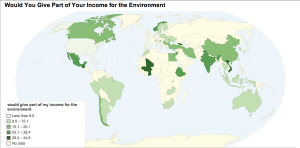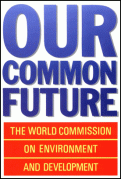TASK: multi-choice pre-assessment on resources and natural capital in class
Understanding Key Words Class brainstorm – defining the concept of a resource:
The term natural capital is used to describe goods or services that are not manufactured but have value to humans. We may be able to process these to add value to them, e.g. mine tin or uranium, turn trees into timber, but they are still natural capital.
natural capital = the ‘stock’ of natural resource e.g. an area of forest
Just as capital yields income in terms of economics, natural capital yields natural income (yield or harvest or services) – factories generate goods and products, cherry trees produce cherries, and the water cycle provides us with fresh water. The measure of the true wealth of a country must include its natural capital, e.g. how many mineral resources, forests, rivers, it has. In general MEDCs add value to natural income by manufacturing goods from it and LEDCs may have greater unprocessed natural capital.
natural income = the ‘flow’ material or services that can be harvested e.g. timber and recreation
Renewable natural capital can replace or restock themselves – they can grow. Timber, for example, can be harvested, and more trees can be planted to be harvested in the future, as long as the environment is managed in a sustainable fashion. Usually, renewable natural capital has solar radiation via photosynthesis as its primary source of energy. Solar radiation itself may also be viewed as a renewable resource as it is produced over such a long timescale. But renewable natural capital can run out if the standing stock (how much is there) is harvested unsustainably, i.e. more is taken than can be replaced by the natural growth rate. Then, it will eventually run out.
Replenishable natural napital will never run out no matter how much we use. Solar radiation is renewable but also replenishable. Wind is another good example.
Non-renewable natural capital exist in finite amounts on Earth and are not replaced after they have been used or depleted (or only over a long timescale – i.e. geological scales). Non-renewable resources include minerals and fossil fuels. As the resource is used, natural capital or stocks are depleted. New sources of stock or alternatives need to be found.
Check your understanding:
TASKS: NATURAL CAPITAL (1) handouts
- Classifying natural capital examples into renewable, non-renewable, recyclable using a check list
- Dynamic nature of natural capital over time and space – factors
How do humans decide on the value of natural capital?
What is World Values Survey?
The World Values Survey (WVS) is a worldwide network of social scientists studying changing values and their impact on social and political life. The WVS in collaboration with EVS (European Values Study) carried out representative national surveys in 97 societies containing almost 90 percent of the world’s population. These surveys show pervasive changes in what people want out of life and what they believe. In order to monitor these changes, the EVS/WVS has executed five waves of surveys, from 1981 to 2007.
Does this sample question reflect a good way to determine the price of a resource with an intrinsic value? “I would give part of my income if I were certain that the money would be used to prevent environmental pollution.1 Strongly agree; 2 Agree; 3 Disagree; 4 Strongly disagree; -1 Don´t know;” etc.
How is the environment (natural capital) valued ‘instrumentally’?
- Economic – having marketable goods or services, e.g. timber and oil
- Ecological – providing life-support services, e.g. water storage and gas exchange by forests.
- Scientific/technological – useful for applications, e.g. genetic, medicinal.
How is the environment (natural capital) valued “intrinsically”?
That is the challenge!
4.Intrinsic – having cultural, aesthetic, spiritual or philosophical (e.g. moral values)
“The question of whether birds, animals and ecosystems have any value outside their use to humans is a philosophical question that environmentalists and economists cannot agree on.” – Sharon Beder
SO… Can the environment really be accurately priced?
Example: What is the value of a tree?
- increasing property values
- modifying wind turbulence
- intercepting the rain
- cooling the air
- stabilising the soil
- reducing fuel costs
- recycling nutrients
- giving privacy
- providing beauty
- reducing stress
- cutting noise
- absorbing toxic substances
- neutralising sewage
- increasing property values
- enhancing social awareness

- promoting tourism
- encouraging recreation
- improving personal health
- providing fruit
- providing habitat for birds and insects
- regulating the water table
- preventing salination
Click on the link below for further reading by Sharon Beder http://www.uow.edu.au/~sharonb/STS300/valuing/price/index.html
What about species? Should Species be Priced?
“(…) it will usually not be environmentalists who control how the analysis is done. It is a risky strategy to embrace methods that make money and species interchangeable. This approach has also been criticised on several other grounds, the first being that species can not be valued. This is because our society is ignorant of most species that exist, the role they play in their ecosystems, how they interact, and the use or value they might be to humans now and in the future. David Ehrenfeld, a US professor of biology, also asks ‘How do we deal with values of organisms whose very existence escapes our notice?’ and ‘What sort of value do we assign to the loss to the community when a whole generation of its children can never experience the streams in their environment as amenities?‘” (1988, p. 215). Read more here.
TASK: Preparing arguments for class debate- “The environment can be intrinsically valued.”
Further reading: What is the value of the biological diversity of the planet?
SUSTAINABLE DEVELOPMENT
TASK: Discuss the concept of sustainable development.
There have been several international summits on sustainable development which have contributed to the development of our changing attitudes (i.e. perspective or worldview) towards sustainability and economic growth. Some of these include the following:
- 1987 – World Commission on the Environment and development (Stockholm) – the definition most commonly used for sustainable development comes from the Bruntland Commission which was the resulting report.
- 1992 – Earth Summit (Rio de Janeiro); Agenda 21 was created – a blue print for sustainable development
- 2002 – World Summit on Sustainable Development (Johannesburg); also known as Rio+10; the Johannesburg “Plan of Implementation of the World Summit on Sustainable Development” was the resulting document/report
- 2012 – Earth Summit (Rio de Janeiro); also known as Rio+20; Revisit of Agenda 21; outcome was the ‘green economy road map’
In order to answer the question, research the following information on your assigned Summit from a range of reliable sources:
- Outline the objectives / aims of the summit
- Describe the outcomes including any key documents, and provide some detail
- How did it contribute to the environmental movement and influence our human population’s worldview / perspective on the environment and economic growth?
- share your written information with your teacher to have it approved
- be creative and video your presentation – share this with your teacher as well
- you will be both peer assessed and teacher assessed, predominantly on knowledge and understanding, application and use
How can we consume a sustainable yield from natural capital?
Can we calculate a natural capital’s sustainable yield?
Class notes (presentation) 3.2.5 Sustainable Yield (catch)
Check your understanding:
What is the tragedy of the commons?
Tragedy Of The Commons: A metaphor used to illustrate the conflict between individual interests and the common good. The term was popularised by Garrett Hardin in his 1968 Science article “The Tragedy of the Commons.” – How is the metaphor relevant to natural capital?








